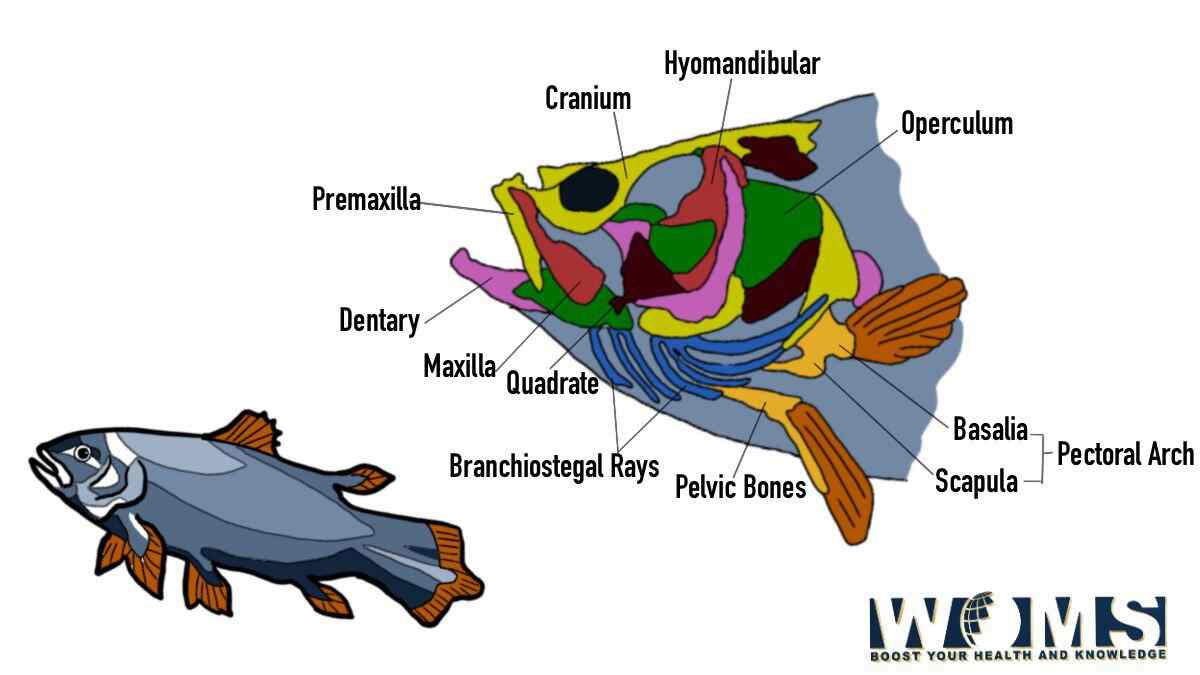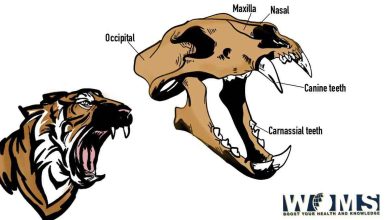Fish Skull Anatomy: Images and Significance

Fish is one of the well-known aquatic animals around the world. It uses relatively more than 20 movable skeleton components in its rapidly evolving skulls to accomplish several complicated manipulation activities. Fish skulls are made up of a collection of juvenile bones that are hazily attached. Except for a few, most fishes’ skulls are linked to the body.
In this article, we’ll examine the fish skull, its components, the way fish move, and the obscure mysticisms that lie behind it.
Illustration of Fish
Fish are cold-blooded, unlike mammals (ectothermic). This implies that overall body temperature is significantly changed by animal environments rather than being maintained at a fixed interior level. Real fish possess fins and a backbone. The majority possess scales covering their body and use gills to breathe. Evolution of Fishes are thought to have started around 480 million centuries back. Fish are believed to exist in 22,000 different species.
Fish are categorized into three superclasses: cartilaginous fish (Osteichthyes), jawless fish (Agnatha), and bony fish (Osteichthyes) (Chondrichthyes). Fish with ray fins belong to the class Actinopterygii, while fish with lobe fins belong to the class Sarcopterygii. Both groups of fish have bony bones.
Undoubtedly, one of the greatest crucial components of a fish’s body is its fins. The main purpose of these fins is to help the body maintain proper equilibrium. It plays a significant role in the fish’s propulsion and steering in the water. There is no doubt that almost all fish have two distinct kinds of fins. Several single fins are mainly found at the upper and bottom portions of the body along the body’s midline.
The primary purpose of the paired fins is to make sure that hovering and steering occur correctly with little to no difficulty. Therefore, it is clear that all these fins are an essential component of fish anatomy.
Additionally, paired fins can be found on a fish’s body. Just one primary fin which aids a fish in propelling its body forwards while swimming in the water is its tail fin or caudal fin. The anal or dorsal fins, which are located in the top and bottom portions of the fish, are primarily employed to maintain the fish’s balance. The fish would flip over if the dorsal fins weren’t present.
Fish Skull
For use in making freshwater and saltwater streamer fly patterns, Fish Skull is a loaded head with a realistic baitfish contour. The substance used to create the heads is a metal combination that is 100 percent lead-free and proven to be corrosion-free lasting up to 80 hours in seawater.
The streamer patterns gain heaviness when you use Fish Skull. They are made of a thin metal composite, which enables us to produce a fish head with a huge surface region that is genuine in dimension without imposing a lot of weight. A special design element sets the Fish-center Skull’s gravity and 70% of its weight just below the hook shank, creating a “keeling” effect that resembles that of a dumbbell. Either the hook-down or the hookup method can be employed to tie the fly.
One of those items which might give somebody a mildly uneasy feeling is skulls. They may lend a touch of suspense or danger, or they may even make someone terrified to gaze upon the fish tank.
The creation of a fish skull
The term “cranium” also applies to the skull. The fish skull or cranium is a twofold structure that consists of two encapsulated bone “boxes.” The exterior layer of the skull is made up of dermal bone. The skull’s interior is made up entirely of endochondral bone. There is also an operculum mostly on the gill surface. The preoperculum comes first, situated above the gills. The mouth and premaxilla are somewhat close together.
Fish have a set of loosely associated bones that make up the fish skull. Only cartilaginous endocranium, with the upper and lower jaws comprising distinct components, is present in sharks and lampreys. In lungfish and lost fish, extra dermal bone forms a more or less cogent skull roof.
Despite the complexity of its characteristics, it is widely accepted that the neurocranium, or braincase, and branchial cranium, two markedly opposing parts, make up the conventional fish skull, or syncranium. The neurocranium comprises two main groups of bones: several superficial ectosteal, or derm bones, and a sequence of inner, or endosteal, components which helps to preserve the upper end found in the notochord, the optic, and otic confinement.
The microscopic component of this derm bony structure has been formerly comparable to that of ganoid scales, but it has long since lost its enamel-like covering. The lateral line structures that travel over or across a number of them have bloated, tunneled, or damaged several of them. The Deeper Layers of the Skin, which are increasingly frequently covering them, also transform them in numerous aspects.
The maxillae are located in the mouth next to the Palatine. The angular is located between the palatine and the dentary, while the dental is at the bottom of the jaw. The quadrate is located between the palatine and hyomandibular, and the hyomandibular and cranium are linked. The Palatine is referred to as the mouth roof.
Composition Of Fish Skull Bones
The amount of bones in a fish skull varies, but the average is probably between 130 and 140. The number, order, and location of the bones in the skulls of vertebrates vary greatly, and this variation can be a reflection of the animal’s needs for mobility as well as the way the skull is used. For instance, fish possess additional skull bones and lesser fusions than most other vertebrates, which allows them to have extremely dynamic skulls.
Even more, jaws, known as pharyngeal jaws, can be found within the external jaws of several fish species. Individuals require a lot of bones to support the mobility inside the skull, known as cranial kinesis. These mechanical connections must be kept in good working order so that muscles may move different sections of the head concerning one another.
Evolution of the brain and skull
The evolutionary origin of the brain and braincase of fishes remains largely elusive. The development of the vertebrate skull is dependent on the presence of an embryonic neural crest whose cells migrate to induce the formation of various elements of the cranial skeleton, dentitions, and certain soft tissues. Much progress has been made in the understanding of the vertebrate skull since pioneering anatomical descriptions made last century.
In the last few decades, studies involving micro-anatomy, ontogenetic development, molecular biology, and gene expression have shed light on key developmental processes that seem to be widely shared among vertebrates. However, molecular biology and ontogenetic studies have been restricted to a small number of fish species. There is still much uncertainty about precise homologies between parts of the fish skull of distinct groups of fishes because the vertebrate skull shows remarkable morphological and anatomical plasticity.
Fish Skull’s Protective Role
Fish have craniums, or skulls, that house their brains. The brain is covered by the fish skull, which shields it from trauma and shock.
- Pelvic and Pectoral Girdle: The pectoral girdle connects the pectoral fin to the fish’s skeleton. The fish’s skeleton and pelvic fin are connected by the pelvic girdle. The pectoral girdle and spinal column are not attached to the free-floating pelvic girdle.
- Vertebral Column: Numerous endochondral bones known as vertebrae make up the vertebral column. The vast, spool-shaped core area is the center of one. The vertebral column of the fish is divided into two parts: the trunk and the tail. In the region of the trunk, fish ribs are joined to the spinal column.
Fish have opercular bones, which are four fused bones that cover their gills, in addition to the fish skull bones species share with some other vertebrates.
Conclusion
Fish have a skeleton system made of bones and cartilage, making them vertebrates. The skeletal system of fish contributes to their overall structure. The fish might have only bones or just cartilage that serve to build a skeleton, depending on whether they are bony fish or cartilage fish.
Since all other vertebrates are descended from a single lineage of fish, there would have been a bottleneck in cranial diversity at that time. As a result, other vertebrates have relatively conservative skull morphological characteristics, with most possessing 22 bones. The skull on its own is quite different in fish than in some other vertebrates.
FAQs
Can you heat a fish skull?
A fish’s skull is made up of numerous separate bones that are joined together by cartilage and connective tissue. The skull needs to be cleaned, disassembled, and put back together using model glue or another adhesive after being boiled. The result will look fantastic Assuming individuals execute a decent approach.
Animal skulls—do they contain pathogens?
Have you discovered any animal bones or skulls? They can be filled with all kinds of terrible bacteria, viruses, and parasites, specifically, if there’s enough flesh upon the bones.
Are there skulls in fish?
Fish have skeletons that are either formed of calcified bones (bony fish) or thin, flexible cartilage (cartilaginous fish). The fish’s main physical features are its vertebral column, jaw, ribs, skull, and intramuscular bones.
Do fish have a pain threshold?
“Fish do experience pain. Although it probably differs from what humans experience, it is nonetheless a form of pain. Fish have nociceptors, which are neurons with the ability to sense dangers including extreme heat, extreme pressure, and corrosive chemicals.




